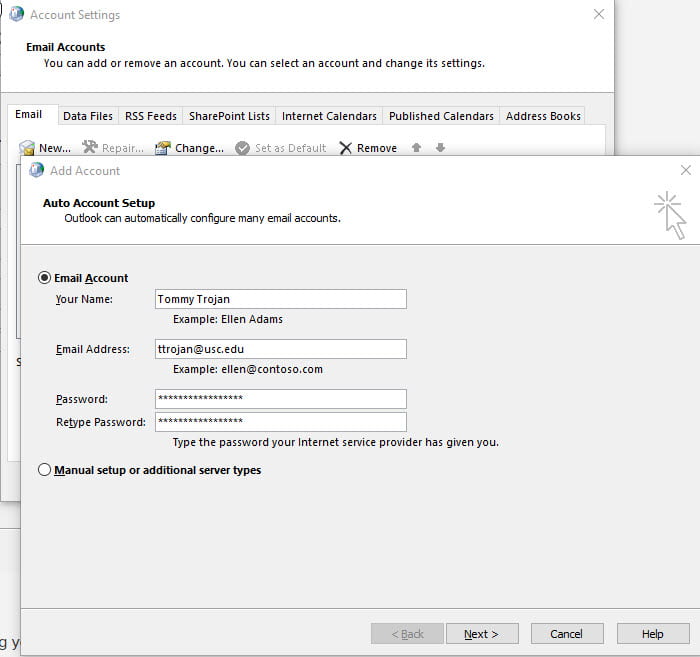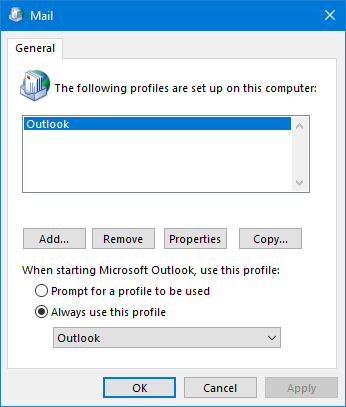- What Version Of Windows Do I Have
- What Version Of Outlook Mail Do I Have
- What Version Of Outlook Do I Have Windows 7
I decided to do an experiment recently in which I switchedto using Outlook Online for all my daily email. So, I put my usual OutlookWindows desktop software aside for a while.
Why would I do this? More and more people are working fromthe web these days, so evaluating Outlook Online is a timely topic. Basically, Iwanted to see how different the two products really were these days. I wantedto see if I could, yet, recommend Outlook Online to my readers.
My conclusion is that Outlook Online is pretty good for basicemail, calendar, and contacts functions, but if you need to process highvolumes of mail, or if you are using my MYN tasks system,you should stick with Windows desktop Outlook.
Want details? Read on.
The main differences between desktop Outlook and OutlookOnline can be summed up in three words: tasks, views, and automation.Windows desktop Outlook does a much better job on all three of these. Let’sstart with tasks.
Outlook Tasks
The Tasks experience in Outlook Online is highly dependent on whether or not you’ve triggered “The new Outlook” setting in the upper right corner of the Tasks window (available only to Office 365 subscribers). That switch looks like this when activated:
Mar 18, 2021 Microsoft Outlook: Browser vs. Download Version With some programs, a 30-day free trial is a perfect solution to getting an expensive program for free. However, when picking an email client, ideally you’re looking for a long term solution. Get questions answered by an Outlook expert any time, any day, when you have Microsoft 365. Custom domain names Easily create a personalized email address (name@yourhobby.com). You'll see this near the bottom of the menu on the left side of your screen. You'll click Help if you see that instead of 'Account.' You should see the 'Version' listing. LookWAYup Full Version Try it Buy it. Online Dictionaries: Translation Dictionary English Dictionary French English English French Spanish English English Spanish.
Now, for some Office 365 accounts, that switch has been removed and you are already in the new Outlook Online experience. Conversely, most corporate accounts don’t have access to this since they are using an on-premises version of Exchange.
The Older Outlook Tasks Module
So, if you are not in the new Outlook mode, then you’ll see the normal, older, Outlook Tasks module, the one that has been around for years within Outlook Online.
This older tasks module offers roughly the same fields as desktop Outlook tasks, but it has only about 10% of the sorting and filtering features. One such missing feature is that it has no ability to drag-sort tasks, something I am favoring these days for my 1MTD system.
Furthermore, you can’t drag-convert emails to tasks. And of course, there is no To-Do Bar tasks list view in Outlook Online with the older tasks module.
So, the older tasks module offers a very limited experience when used online. The result is you cannot use it to implement the MYN system, and you really cannot even use it for the simple 1MTD system either—it’s just not very good.
Microsoft To Do Tasks: The New Tasks Pane
However, if you have triggered “The new Outlook” setting, or if you have it by default, then your task experience is completely different.

First, you now do have a very rough equivalent of theOutlook To-Do Bar available. It’s not sorted right for MYN, but at least it showsa task list along with your email. You activate it by clicking this button inthe upper right part of the window.
Once you click that, you’ll see the Tasks pane appear at the right side of the inbox.
Really what’s happening here is that you are now in the “new”Outlook Online experience, and so you are now using the Microsoft To Do tasksmodule instead of the old tasks module.
And there are some good features in this new module. Among them are you can drag-sort tasks vertically and you can drag emails to that pane to convert emails to tasks (or to calendar events).
Tasks Folder = Microsoft To Do Website
The fact that you are accessing a completely different tasks module in the new Outlook Online is especially noticeable when you click on the Tasks icon in the lower left corner of the Outlook Online window. In desktop Outlook this would take you to the Tasks folder. But in the new Outlook Online, this will redirect you to an entirely different product, the Microsoft To Do website.
I have written about this new Microsoft To Do product extensively,and in fact I have a whole video course on howto use it. I’ve also written a recentarticle on my conclusions about Microsoft To Do. Some of my conclusionshave evolved since I produced those videos, so you might want to read that articletoo.
But the net net is this: unless you are using the new Microsoft To-Do product and Office 365 with Exchange, the Outlook Online tasks experience is pretty worthless, I’d stick with Windows desktop Outlook.
Outlook Online Views
Let’s talk now about the second of the three main differences between Windows desktop Outlook and Outlook Online: Views, and in particular, email list views.
The default Outlook Online Inbox view roughly matches the standard compact view of desktop Outlook. In this view you’ve got a few lines of the email displayed for each item in the inbox list, and you’ve got a Reading pane view of the email off to the right, as I show below.
You can turn that Reading pane on and off if you click Settings(the gear icon in upper right), and then use the controls in the lower portionof the Settings pane that opens.
If you turn the Reading pane off, then you get a single-line list of email in your Inbox, as I show below, one that is roughly similar to the single-line view in desktop Outlook.
Not Good for Speedy Email Processing
These compact and single-line views are okay, but you have very little control over them. For example, if you studied my Outlook Inbox Ninja course, you’ve seen that the inbox in Windows desktop Outlook offers a ton of view options that can greatly speed your processing of email. Not so with Outlook Online.
For example, one problem in the Outlook Online compact inbox view, the top one above, is this: Even if you have a large monitor you cannot drag-widen the inbox list on the left past a certain rather narrow point. And its widest setting is way too narrow in my opinion. There are many other limitations compared with Windows desktop Outlook.
Automation
The third main feature gap in Outlook Online is in automation. Here I mainly refer to limits in using Outlook Rules and Quick Steps. The Rules module on Outlook Online is okay, but it is nowhere as powerful as the one built into Windows desktop Outlook. That will slow you down if you heavily filter your incoming mail, like I recommend.
My bigger complaint is that the Quick Steps feature iscompletely absent in Outlook Online, and Quick Steps is a really nice feature. AsI show in my OutlookInbox Ninja course, one of the great things about Quick Steps is theautomating of one-click filing. Since that’s absent in Outlook Online, itbecomes slow to use folders other than the Archive folder for folder filing.
Conclusion
Outlook Online is quite usable if you have moderate volumes of email, calendar, and contacts. It is a good choice if you have decided to work purely in a web browser environment.
But if you get too much mail and need to process it rapidly, you’ll be greatly disappointed by Outlook Online. Rather, Windows desktop Outlook is the better way to go. And if you want to use my powerful MYN tasks system along with Outlook, there is really no choice: you should be using Windows desktop Outlook to truly get control of your tasks.
Topics Map > Frequently Asked Questions > Client Support
Topics Map > Features and Functionality > Client Capabilities > Desktop
This document describes how you can determine the version of Office you have installed on your computer. These instructions assume you already have an Outlook profile/account configured. If you do not have Outlook configured, you can substitute Outlook with any of the other Office applications in the steps below.
Important: To get the latest features/updates, it is recommended that you install the Microsoft Office 365 ProPlus/Subscription/enterprise version of Office/Outlook. The Professional Plus/2016/2019/Volume License version is only receiving security updates.
What Version Of Windows Do I Have
- Note - Windows 7 End of Support and Office 365 ProPlus
As announced previously, Windows 7 will be out of support after January 14, 2020. Because Office 365 is governed by the Modern Lifecycle Policy, customers are required to stay current as per the servicing and system requirements for the product or service. This includes using Office 365 ProPlus on a Windows operating system that is currently in support.
Using Office 365 ProPlus on older, unsupported operating systems may cause performance and reliability issues over time. If your organization is using Office 365 ProPlus on devices running Windows 7, we strongly recommend your organization move those devices to Windows 10.
[How does this impact me?]
Even though Windows 7 will no longer be supported after January 2020, we understand Office 365 customers may need more time in their migration to a supported operating system. Through January 2023, Microsoft will provide security updates for Office 365 ProPlus on Windows 7. But, during that time, as long as the device is still running Windows 7, Office 365 ProPlus won’t receive any new features updates.
[What should I do to prepare for this change?]
We recommend that organizations migrate to Windows 10 or a supported operating system before the end of support date on January 14, 2020 in order to continue receiving new feature updates to Office 365 ProPlus. Make sure to discuss this process with your local IT staff before making changes to your system.
We’ll be providing more information by January about how to get security updates for Office 365 ProPlus on devices running Windows 7 after support for Windows 7 ends.
Note: This information also applies to Office 365 Business which is included in business plans such as M365 Business and Office 365 Business Premium, and to desktop versions of Project and Visio.
For more information, please see this support article and this FAQ.
Select your operating system:
What Version Of Outlook Mail Do I Have
Windows OS
- Start Outlook/Word or any other Microsoft Office application.
- On the File menu, click Office Account or Account.
- Under Product Information, you'll see the general version of Office installed on your computer.
This version was downloaded/installed from your Office
365 subscription - you must have an active Office 365
ProPlus license/subscription to run this version.
This version was downloaded/installed from Campus Software Library (CSL). - For complete version, click About Outlook/Word. A new window will appear. The top will display the build information and if the client is 32- or 64-bit.
- Click left arrow to return to Outlook/Word.
Mac OS
What Version Of Outlook Do I Have Windows 7
- Start Outlook/Word or any other Microsoft Office application.
- From the Outlook menu on the Apple menu bar, select About Outlook.
- You will be presented with the 'About Outlook/Word' screen:
This version was downloaded/installed from your Office 365
subscription - you must have an active Office 365 ProPlus
license/subscription to run this version.
This version was downloaded/installed from Campus Software
Library (CSL). - Click red X to return to Outlook/Word.

See Also:
